
A | B | C | D | E | F | G | H | CH | I | J | K | L | M | N | O | P | Q | R | S | T | U | V | W | X | Y | Z | 0 | 1 | 2 | 3 | 4 | 5 | 6 | 7 | 8 | 9
The examples and perspective in this article deal primarily with the United States and do not represent a worldwide view of the subject. (June 2019) |
The following is a timeline of labor history, organizing & conflicts, from the early 1600s to present.
| Part of a series on |
| Organized labour |
|---|
 |
1600s
- 1619 (United States)
- 1619 Jamestown Polish craftsmen strike.
- 1661 (United States)
- Virginia's Indentured Servants' Plot.[1]
- 1676 (United States)
- Bacon's Rebellion in Virginia.[1]

- 1677 (United States)
- New York City Carter's Strike.[1]
- 1684 (United States)
- New York City Carter's Strike.[1]
1700s
- 1741 (United States)
- New York City Bakers' Strike.[1]
- 1774 (United States)
- Hibernia, New Jersey, Ironworks Strike.[1]
- 1778 (United States)
- Journeymen printers in New York combine to increase their wages.[1]
- 1781 (Austria)
- Holy Roman Emperor, Joseph II, issues the Serfdom Patent of 1781, to abolish serfdom throughout the Habsburg lands.
- 1791 (United States)
- Philadelphia carpenters conduct first strike in the building trades in the United States.[1]
- 1792 (United States)
- Philadelphia has first local union in the United States organized to conduct collective bargaining.[1]
- 1794 (United States)
- Federal Society of Journeymen Cordwainers formed in Philadelphia.[1]
- 1797 (United States)
- Profit sharing originated at Albert Gallatin's glassworks in New Geneva, Pennsylvania.
- 1799 (England)
- Combination Act outlawed trade unionism and collective bargaining by workers.[2]
1800-1829
- 1805 (United States)
- Journeymen Cordwainers union includes a closed-shop clause in its constitution in New York City.[1]
- 1806 (United States)
- Commonwealth v. Pullis was the first known court case arising from a labor strike in the United States. After a three-day trial, the jury found the defendants guilty of "a combination to raise their wages" and fined.[1]
- 1816 (England)
- Food riots broke out in East Anglia. Workers demanded a double wage and for the setting of triple prices for food.[3]
- 1824 (England)
- The Combination Act of 1799 was repealed.[2]
- 1824 (United States)
- Pawtucket, Rhode Island, Textile Strike.[1]
- 1825 (United States)
- United Tailoresses of New York organized in New York City.[1]
- 1825 (United States)
- Boston House Carpenter's Strike [1]
- 1827 (United States)
- Mechanics' Union of Trades' Associations formed in Philadelphia.[1]
- 1827 (United States)
- Philadelphia Carpenter's Strike.[1]
- 1828 (United States)
- Workingmen's Party was organized in Philadelphia by the Mechanics' Union of Trades' Associations.[1][4]
- 23 April 1829 (United States)
- Committee of Fifty, a group of prominent trade unionists in New York City, organized to resist efforts by business owners to revoke the 10-hour workday and reinstate the 11-hour workday.[5] Their efforts lead directly to the forming of the Workingmen's Party of New York.[5]
- 1829 (United States)
- Workingmen's Party of New York formed.[1][5]
1830s
- 1831 (United States)
- New England Association of Farmers, Mechanics, and other Workingmen formed.[6]
- 9 January 1831 (England)
- Twenty-three workers from Buckingham were sentenced to death for destruction of a paper machine by one of a number of Special Commissions sent to East Anglia to suppress insurgent workers by the Whig Ministry.[7]
- 11 January 1831 (England)
- Three workers in Dorset were sentenced to death for extorting money and two workers were sentenced to death for robbery by one of the Special Commissions sent by the Whig Ministry to suppress insurgent workers.[7]
- Fifty-five workers in Norwich were convicted of "machine breaking and rioting" by one of the Special Commissions sent by the Whig Ministry to suppress insurgent workers.[7]
- Three workers in Ipswich were convicted of extorting money by one of the Special Commissions sent by the Whig Ministry to suppress insurgent workers.[7]
- In Petworth, 26 workers were found guilty of "machine breaking and rioting" by one of the Special Commissions the Whig Ministry sent by the Whig Ministry to suppress insurgent workers.[7]
- "Upwards of thirty" workers in Gloucester were convicted of "machine breaking and rioting" by one of the Special Commissions sent by the Whig Ministry to suppress insurgent workers.[7]
- Twenty-nine workers in Oxford were convicted of "machine breaking and rioting" by one of the Special Commissions sent by the Whig Ministry to suppress insurgent workers.[7]
- 1832 (United States)
- Boston Ship Carpenters' Ten-Hour Strike.[6]
- 1833 (United States)
- Lynn, Massachusetts' Shoebinders' Protest begins.[6]

- 1834 (England)
- The Tolpuddle Martyrs, agricultural workers who formed a trade union in Tolpuddle in Dorsetshire, were sentenced by a Whig Ministry Special Commission to transportation to a penal colony in Australia.[7]
- March 1834 (United States)
- National Trades' Union formed in New York when the New York General Trades' Union solicited labor organizations from around the country to send delegates to a national convention.[8] This union was the first attempt to create a national labor federation.[6]
- 1834 (United States)
- Lowell, Massachusetts Mill Women's Strike.[6]
- 1834 (United States)
- Manayunk, Pennsylvania Textile Strike.[6]
- 1835 (United States)
- Carpenters, masons, and stone-cutters began a strike as part of the Ten-Hour Movement among skilled workers.[6] They drafted a strike circular in Boston outlining their demands and seeking assistance from other tradespeople. Wherever this circular was distributed, a strike in favor of the ten-hour workday erupted. The 1835 Philadelphia general strike, in which workers successfully struck for shorter working hours and higher wages, was influenced by the Boston circular.[9]
- 3 July 1835 (United States)
- Textile workers, many of whom were children of Irish descent, launched the 1835 Paterson textile strike in the silk mills in Paterson, New Jersey fighting for the 11-hour day, 6 days a week.[6]
- 1836 (United States)
- National Cooperative Association of Cordwainers formed in New York City. This association was the first national union for a specific craft.[6]
- 1836 (United States)
- Lowell, Massachusetts, Mill Women's Strike.[6]
- 1836 (United States)
- New York City Tailors' Strike.[6]
- 1836 (United States)
- Philadelphia's Bookbinders' Strike.[6]
1840s
- 1840 (United States)
- Ten-hour day for federal employees on federal public works projects without loss of pay established by President Martin Van Buren by executive order.[6][10]
- 1842 (United States)
- Ten-hour Republican Association was formed by New England mechanics to pressure the Massachusetts legislature to establish a ten-hour workday throughout the state.[11]
- March 1842 (United States)
- Commonwealth v. Hunt was a landmark legal decision by the Massachusetts Supreme Judicial Court on the subject of labor unions. Chief Justice Lemuel Shaw ruled that unions were legal organizations and had the right to organize and strike. Before this decision, labor unions which attempted to 'close' or create a unionized workplace could be charged with conspiracy.[6] See Commonwealth v. Pullis

- 1844 (United States)
- Lowell Female Labor Reform Association formed.[6]
- April 1844 (United States)
- Fall River Mechanics' Association established 'The Mechanic', a weekly paper dedicated "to advocate the cause of the oppressed Mechanic and Laborer in all its bearings."[12]
- 1847 (Scotland)
- The Educational Institute of Scotland, the oldest teachers' trade union in the world, was founded.
- 1847 (United States)
- New Hampshire is first state to establish the ten-hour workday.[6]
- 1848 (United States)
- Pennsylvania's child labor law establishes the age of 12 as the minimum age for workers in commercial occupations.[6]
- 1848 (Germany)
Founding of the Allgemeine Deutsche Arbeiterverbrüderung (General German Workers-Brotherhood) [13]
1850s
- 1850 (United States)
- New York City Tailor's Strike.[6]
- 13 June 1850 (United States)
- American League of Colored Laborers established in New York City.[14]
- July 1851 (Australia)
- Eureka Rebellion in the Colony of Victoria, Australia.

- July 1851 (United States)
- Two railroad strikers are shot dead and others injured by the state militia in Portage, New York.
- 1852 (United States)
- Typographical Union founded.[6]
- 21 April 1856 (Australia)
- Stonemasons and building workers in Melbourne achieve an eight-hour day, the first organized workers in the world to achieve an 8-hour day, with no loss of pay.[citation needed][15]
- 1859 (United States)
- Iron Molders' International Union founded.[6]
1860s

- 1860 (United States)
New England Shoemakers Strike of 1860
- 800 women operatives and 4,000 workmen marched during a shoemaker's strike in Lynn, Massachusetts.
- 1863 (United States)
- The first railroad labor union, The Brotherhood of the Footboard (later renamed the Brotherhood of Locomotive Engineers) is formed in Marshall, Michigan.[6] It is headed by William D. Robinson.[16]
- 1864 (Europe)
- International Workingmen's Association (often called the First International) is founded.
- 1864 (United States)
- Cigar Makers' Union founded.[6]
- 1864 July 21 (United States)
- Operative Plasterers' and Cement Masons' International Association founded.[6]
- 1866 (United States)
- National Labor Union formed - 1st national labor federation in the US.[6]
- 1866 (United States)
- Molders' Lockout takes place.[6]
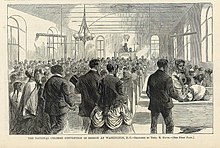
- 1867 (United States)
- Order of the Knights of St. Crispin, a union for factory workers in the shoe industry, founded.[6]
- 1868 (Germany)
- The Allgemeiner Deutscher Gewerkschaftsbund (ADGB)(Federation of General German Civil Servants) was founded and represented 142,000 workers.[17]
- 1868 (United States)
- First U.S. federal eight-hour law passed. This law only applied to laborers, workmen, and mechanics employed by the U.S. federal government.[6]
- 1869 (United States)
- Colored National Labor Union founded.[18]
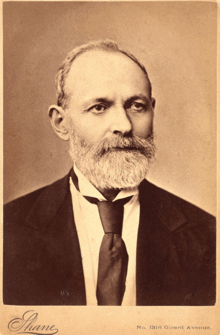
- 1869 (United States)
- Uriah Smith Stephens organized a new union known as the Knights of Labor.[18]
- 1869 (United States)
- Collar Laundry Union Strike in Troy, New York.[18]
1870s
- 1870 (United States)
- The first written contract between coal miners and coal miner operators signed.[18]
- 1872 (Europe)
- Karl Marx ejects Mikhail Bakunin and the other anarchists from the International Workingmen's Association
- 1873 (United States)
- In 1873 the Brotherhood of Locomotive Firemen was established. In 1906 it became the Brotherhood of Locomotive Firemen & Enginemen.
- 13 January 1874 (United States)
- The original Tompkins Square Riot occurs in New York City.[18] As unemployed workers demonstrated in New York City's Tompkins Square Park, a detachment of mounted police charged into the crowd, beating men, women and children indiscriminately with billy clubs and leaving hundreds of casualties in their wake.
- 1874 (United States)
- Peter M. Arthur elected Grand Chief of the Brotherhood of Locomotive Engineers. He remained in office until his death.[19]
- 1875 (United States)
- The Molly Maguires are convicted for the anthracite coalfield murders.[18]
- 1875 (United States)
- Anthracite Coal Strike takes place.[18]
- 1876 (United States)
- Amalgamated Association of Iron, Steel, and Tin Workers founded.[18]
- 1876 (United States)
- Workingmen's Party is founded. It later becomes the Socialist Labor Party.[18]

- 1876 (United States)
- Greenback Party is founded.[18]
- 1877 (United States)
- Cigar Makers' International Union occurred.[18]
- 1877 (United States)
- San Francisco Anti-Chinese Riots occur.[18]
- 12 February 1877 (United States)
- The Great Railroad Strike of 1877[18] -- U.S. railroad workers began strikes to protest wage cuts. It started in Martinsburg, West Virginia, and then spread to many other states.
- 14 July 1877 (United States)
- A general strike halted the movement of U.S. railroads. In the following days, strike riots spread across the United States. The next week, federal troops were called out to force an end to the nationwide strike. At the "Battle of the Viaduct" in the Pilsen neighborhood of Chicago, between protesting members of the Chicago German Furniture Workers Union, now Local 1784 of the Carpenters Union, and federal troops killed 30 workers and wounded over 100.

- 1878 (United States)
- Socialist Labor Party of America founded when the Workingmen's Party of the United States voted to change its name at its December 1877 convention.[18]
- 1878 (United States)
- Greenback Labor Party founded.[18]
- 1878 (United States)
- International Labor Union founded.[18]
1880s
- 1881 (United States and Canada)
- Federation of Organized Trades and Labor Unions, the ender of the American Federation of Labor, was founded in the United States and Canada.[18]
- 1881 (United States)
- Brotherhood of Carpenters and Joiners was founded.[18]
- 1881 (United States)
- Revolutionary Socialist Labor Party was founded.[18]
- 1882 (United States)
- Cohoes, New York, Cotton Mill Strike occurred.[18]
- 5 September 1882 (United States)
- Thirty thousand workers marched in the first Labor Day parade in New York City.

- 1883 (Canada)
- The Trades and Labour Congress of Canada (TLC), a Canada-wide central federation of trade unions was formed.
- 1883 (United States)
- International Working People's Association formed.[18]
- 1883 (United States)
- Lynchburg, Virginia, Tobacco Workers' Strike occurred.[18]
- 1883 (United States)
- Molder's Lockout began.[18]
- 1884 (United States)
- The Federation of Organized Trades and Labor Unions, forerunner of the American Federation of Labor, passed a resolution stating that "8 hours shall constitute a legal day's work from and after May 1, 1886."
- 1884 (United States)
- Federal Bureau of Labor established in the U.S. Department of the Interior.[18]
- 1884 (United States)
- Fall River, Massachusetts, Textile Strike occurred.[18]
- 1884 (United States)
- Union Pacific Railroad Strike occurred.[18]
- 1885 (United States)
- U.S. Congress passed the Foran Act outlawing immigration of laborers on contract.[18]
- 1885 (United States)
- Cloakmakers' General Strike occurred.[18]
- 1885 (United States)
- McCormick Harvesting Machine Company Strike occurred.[18]
- 1885 (United States)
- Southwest Railroad Strike occurred.[18]
- 1885 (United States)
- Yonkers, New York, Carpet Weaver' Strike occurred.[18]
- 1885 (United States)
- Ten coal-mining activists ("Molly Maguires") were hanged in Pennsylvania.
- 1886 (United States)
- Augusta, Georgia Textile strike occurred.[20]
- 1886 (United States)
- Cowboy Strike occurred.[20]
- 1886 (United States)
- McCormick Harvesting Machine Company Strike occurred.[20]
- 1886 (United States)
- Troy, New York, Collar Laundresses Strike occurred.[20]

- March 1886 (United States)
- The Great Southwest Railroad Strike of 1886 was a labor union strike against the Union Pacific and Missouri Pacific railroads involving more than 200,000 workers.[20]
- 1 May 1886 (United States)
- Workers protested in the streets to demand the universal adoption of the eight-hour day. Hundreds of thousands of American workers had joined the Knights of Labor. The movement ultimately failed.[20]

- 1 May 1886 (United States)
- Bay View Tragedy: About 2,000 Polish workers walked off their jobs and gathered at St. Stanislaus Church in Milwaukee, Wisconsin, angrily denouncing the ten-hour workday. The protesters marched through the city, calling on other workers to join them. All but one factory was closed down as sixteen thousand protesters gathered at Rolling Mills. Wisconsin Governor Jeremiah Rusk called the state militia. The militia camped out at the mill while workers slept in nearby fields. On the morning of 5 May, as protesters chanted for the eight-hour workday, General Treaumer ordered his men to shoot into the crowd, some of whom were carrying sticks, bricks, and scythes, leaving seven dead at the scene, including a child.[21][22]
- The Milwaukee Journal reported that eight more would die within twenty-four hours, adding that Governor Rusk was to be commended for his quick action in the matter.
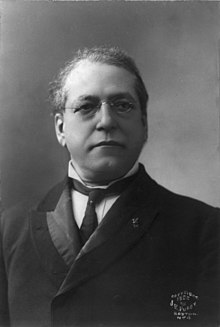
- 1886 (United States)
- American Federation of Labor founded. Samuel Gompers served as first president.[20]

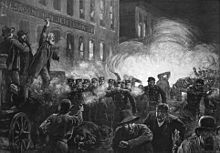

- 4 May 1886 (United States)
- Anarchist rally lead to the Haymarket Riot in Chicago, Illinois, the origin of international May Day observances.[20]
- 22 November 1887 (United States)
- In the Thibodaux massacre in Thibodaux, Louisiana a local militia, aided by bands of "prominent citizens," shot at least 35 unarmed black sugar workers striking to gain a dollar-per-day wage, and lynched two strike leaders.
- 1887 (United States)
- Seven of the Haymarket Riot bombing defendants sentenced to death, of which five are executed.[20]
- 1887 (United States)
- Port of New York Longshoremen's Strike occurred.[20]

- June 1888 (United Kingdom)
- The London matchgirls strike of 1888 was a strike of the women and teenage girls working at the Bryant and May Factory in Bow, London. The strike was prompted by the poor working conditions in the match factory, including fourteen-hour work days, poor pay, excessive fines, and the severe health complications of working with yellow (or white) phosphorus, such as phossy jaw.
- 1888 (United States)
- United States enacted first federal labor relations law; the law applied only to railroads.[20]
- 1888 (United States)
- International Association of Machinists founded.[20]
- 1888 (United States)
- Burlington Railroad Strike occurred.[20]
- 1888 (United States)
- Cincinnati Shoemakers' Lockout occurred.[20]
- 1889 (United States)
- Baseball Players' Revolt began.[20]
- 1889 (United States)
- Fall River, Massachusetts, Textile Strike occurred.[20]
- 1889 (Europe)
- The Second International is founded. Declaration of 1 May as International Workers Day.
1890s
- 1890 (United States)
- United Mine Workers of America founded.[20]
- 1890 (United States)
- United Brotherhood of Carpenters and Joiners of America Strike occurred; the union demanded an eight-hour work day.[20]
- 25 July 1890 (United States)
- New York garment workers won the right to unionize after a seven-month strike. They secured agreements for a closed shop, and firing of all strikebreakers.
- 1891 (United States)
- Savannah, Georgia, Black Labourers' Strike occurred.[20]
- 1891 (United States)
- Tennessee Miners' Strike occurred.[20]

- 1892 (United States)
- International Longshoremen's Association founded.[20]
- 1892 (United States)
- International Seamen's Union founded.[20]
- 1892 (United States)
- New Orleans General Strike occurred.[20]
- 6 July 1892 (United States)
- Homestead Strike:[20] Pinkerton Guards, trying to pave the way for the introduction of strikebreakers, opened fire on striking Carnegie mill steel-workers in Homestead, Pennsylvania. In the ensuing battle, three Pinkertons surrendered and were set upon and beaten by a mob of townspeople, most of them women. Seven guards and eleven strikers and spectators were shot to death.[23]
- 11 July 1892 (United States)
- Coeur d'Alene, Idaho labor strike of 1892: Striking miners in Coeur d'Alene, Idaho dynamited the Frisco Mill, leaving it in ruins.
- August 1892 (United States)
- Buffalo Switchmen's Strike collapses after two weeks when 8,000 New York State militia enter the city and peer unions fail to come to the strikers' aid.
- 1893 (United States)
- American Railway Union founded.[20]
- 1893 (United States)
- Western Federation of Miners founded.[20]
- 1893 (United States)
- Federal court in Louisiana rules that the Sherman Antitrust Act applies to unions and finds that sympathy strikes restrain trade.[20]
- 1893 (United States)
- National Civic Federation founded.[20]
- 1893 (United States)
- Unions helped win the passage of the Safety Appliance Act. Among other things, the Act outlawed the "old man-killer link and pin coupler" by railroads.
- 1894 (United Kingdom)
- History of Trade Unionism, the influential book by Sidney and Beatrice Webb is first published.
- 1894 (United States)
- Coxey's Army marched on Washington, D.C.[20]
- 7 February 1894 (United States)
- In Cripple Creek, Colorado, miners went on strike when mine owners announced an increase from eight to ten hours per day, with no increase in wages.[20] This strike marked perhaps the only time in American history that a state militia was called out to protect miners from sheriff's deputies.
- 21 April – June 1894 (United States)
- Bituminous Coal Miners' Strike of 1894 -- A two-month nationwide strike by miners of hard coal in the United States. This unsuccessful strike almost destroyed the United Mine Workers union.

- 11 May – 10 July 1894 (United States)
- Pullman Strike: A nation-wide strike against the Pullman Company begins with a wildcat walkout[20] on 11 May after wages are drastically reduced. On 5 July, the 1892 World's Columbian Exposition in Chicago's Jackson Park was set ablaze, and seven buildings were burned to the ground. The mobs burned and looted railroad cars and fought police in the streets, until 10 July, when 14,000 federal and state troops finally succeeded in putting down the strike, killing 34 American Railway Union members. Leaders of the strike, including Eugene Debs, were imprisoned for violating injunctions, causing disintegration of the union.[23]
- 1895 (France)
- The Confédération Générale du Travail (CGT), was formed. This French union is the oldest confederation still in existence.
- April 1895 (United States)
- American Industrial Union established by former American Railway Union Vice President George W. Howard. The union proves to be short-lived, disappearing in the second half of 1896.[24]
- June 1895 (United States)
- U.S. Supreme Court rules in In re Debs to uphold an injunction against the Pullman Strikers on the grounds that the federal government is empowered to regulate interstate commerce.[20]
- 1895 (United States)
- Socialist Trade and Labor Alliance founded.[20]
- 1895 (United States)
- Haverhill, Massachusetts, Show Strike occurred.[20]
- 21 September 1896 (United States)
- The state militia was sent to Leadville, Colorado to break a miner's strike.[20]

- 10 September 1897 (United States)
- Lattimer massacre: 19 unarmed striking coal miners and mine workers were killed and 36 wounded by a posse organized by the Luzerne County sheriff for refusing to disperse near Hazleton, Pennsylvania.[20] The strikers, most of whom were shot in the back, were originally brought in as strike-breakers, but later organized themselves.
- 1898 (United States)
- The Erdman Act was passed providing for mediation and voluntary arbitration on the railroads.[20] It made it a criminal offense for railroads to dismiss employees or to discriminate against prospective employees because of their union membership or activity. It provided legal protection of employees' rights to membership in a labor union, a limit on the use of injunctions in labor disputes, lawful status of picketing and other union activities, and requirement of employers to bargain collectively. Subsequently, a portion of the Erdman Act, which would have made it a criminal offense for railroads to dismiss employees or discriminate against prospective employees based on their union activities, was declared invalid by the United States Supreme Court.
- 1898 (United States)
- American Labor Union founded.[20]
- 1898 (United States)
- Marlboro, Massachusetts, Shoe Workers' Strike began.[20]

- 1899 (United States)
- Miners in Idaho dynamite a mill in retaliation for the Bunker Hill Mining Company firing 17 union members.[25]
- 1899 (United States)
- Brotherhood of Teamsters founded.[25]
- 1899 (United States)
- Buffalo, New York, Grain Shoveler's Strike occurred.[25]
- 1899 (United States)
- Cleveland, Ohio, Street Railway Worker's Strike occurred.[25]
- 1899 (United States)
- Newsboys Strike of 1899 occurred in New York City.[25]
1900s
- 1900 (United States)
- International Ladies' Garment Workers Union founded.[25]
- 1900 (United States)
- Anthracite Coal Strike occurred.[25]
- 1900 (United States)
- Machinists' Strike occurred.[25]
- 1901 (United States)
- United Textile Workers founded.[25]
- 1901 (United States)
- Machinists' Strike occurred.[25]
- 1901 (United States)
- National Cash Register Strike occurred.[25]
- 1901 (United States)
- San Francisco Restaurant Workers' Strike occurred.[25]
- 1901 (United States)
- U.S. Steel Recognition Strike of 1901 occurred.[25]

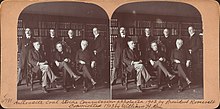
- 15 May 1902 (United States)
- Coal Strike of 1902[25] -- United Mine Workers of America in the anthracite coal fields of eastern Pennsylvania struck in seven counties, from May through October. The strike caused a nationwide coal shortage. President Theodore Roosevelt imposed the first mediated agreement of its kind.
- 1902 (United States)
- Chicago Teamsters' Strike occurred.[25]
- 1903 (United States)
- U.S. Department of Commerce and Labor created.[25]
- 1903 (United States)
- Women's Trade Union League founded.[25]
- 1903 (United States)
- Oxnard, California, Sugar Beet Strike occurred.[25]
- 1903 (United States)
- Carbon County Strike began.[25]
- 23 November 1903 (United States)
- Colorado Labor Wars: Troops were dispatched to Cripple Creek, Colorado to defeat a strike by the Western Federation of Miners,[25] with the specific purpose of driving the union out of the district. The strike had begun in the ore mills earlier in 1903, and then spread to the mines.
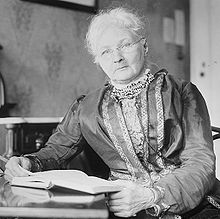
- July 1903 (United States)
- Labor organizer Mary Harris "Mother" Jones leads child workers in demanding a 55-hour work week.
- 1904 (United States)
- New York City Interborough Rapid Transit Strike.[25]
- 1904 (United States)
- United Packinghouse Workers of America.[25]
- 1904 (United States)
- Santa Fe Railroad Shopmen's Strike.[25]
- 8 June 1904 (United States)
- A battle between the Colorado Militia and striking miners at Dunnville ended with six union members dead and 15 taken prisoner. Seventy-nine of the strikers were deported to Kansas two days later.
- 1905 (United States)
- Industrial Workers of the World founded in Chicago, Illinois.[25]
- 17 April 1905 (United States)
- The Supreme Court held in Lochner v. New York that a maximum hours law for New York bakery workers was unconstitutional under the due process clause of the 14th amendment.[25]
- 1906 (United States)
- An eight-hour workday is widely adopted in the printing industry.[25]
- 1907 (United States)
- Goldfield, Nevada, Miners' Strike began.[25]

- 1908 (United States)
- The Federal Employers' Liability Act was passed. Also that year, the Erdman Act was further weakened by the Supreme Court when Section 10, related to use of "yellow dog" contracts, was declared unconstitutional (see 1898).[25]
- 1908 (United States)
- U.S. Supreme Court rules in Danbury Hatters Case that a boycott launched by the United Hatters Union is a conspiracy in restraint of trade under the Sherman Antitrust Act.[25]
- 1908 (United States)
- U.S. Supreme Court rules in Muller vs. Oregon that an Oregon law that limited the working hours for women was unconstitutional.[25]
- 1908 (United States)
- IWW Free Speech Fight began in Missoula, Montana.[25]
- 1909 (United States)
- National Association for the Advancement of Colored People founded.[25]
- 1909 (United States)
- IWW Free Speech Fight began in Spokane, Washington.[25]

- 1909 (United States)
- McKees Rocks, Pennsylvania, Steel Strike began.[25]
- 1909 (United States)
- Watertown, Connecticut, Arsenal Strike occurred.[26]

- 22 November 1909 (United States)
- The New York shirtwaist strike of 1909 (Uprising of the 20,000) began. Female garment workers went on strike in New York; many were arrested. A judge told those arrested: "You are on strike against God".[26]
1910s
- 1910 (United States)
- Bethlehem Steel Strike occurred.[26]
- 1910 (United States)
- Cloakmakers' Strike occurred.[26]
- 1910 (United States)
- Chicago Clothing Workers' Strike occurred.[26]
- 1910 (United States)
- The 1910 Accident Reports Act was passed and a 10-hour work day and standardization of rates of pay and working conditions were won by the Railway Brotherhoods.
- Union membership topped 8 million workers in 1910.

- 1 October 1910 (United States)
- The Los Angeles Times bombing killed twenty people and destroyed the building. Calling it "the crime of the century," the newspaper's owner Harrison Gray Otis blamed the bombing on the unions, a charge denied by unionists.
- 1 November 1910 (Spain)
- The Confederación Nacional del Trabajo was founded.
- 25 December 1910 (United States)
- A dynamite bomb destroyed a portion of the Llewellyn Iron works in Los Angeles, where a strike was in progress. In April 1911 James B. McNamara and his older brother John F. McNamara, secretary-treasurer of the International Association of Bridge and Structural Iron Workers, were charged with the two crimes. James McNamara pleaded guilty to murder and John McNamara pleaded guilty to conspiracy in the dynamiting of the Llewellyn Iron Works.[27]
- 1911 (United States)
- The Locomotive Inspection Act passed. Four years later, the Hours of Service Act passed. The Railroad Brotherhoods had won an eight-hour day.
- The Supreme Court in Gompers v. Buck's Stove and Range Co. (221 U.S. 418) affirmed a lower court order for the AFL to stop interfering with Buck's Stove and Range Company's business or boycotting its products or distributors.[26]
- On 24 June 1912 in the second contempt trial, the defendants (Samuel Gompers, John Mitchell, and Frank Morrison) were again found guilty and sentenced to prison. The Supreme Court overturned the convictions because the new proceedings had not been instituted within the three-year statute of limitations (233 U.S. 604 1914).[27]
- 1911 (United States)
- Illinois Central and Harriman Line Rail Strike occurred.[26]
- 1911 (United States)
- Southern Lumber Operators' Lockout began.[26]
- 1911 (Wales)
- Two men are shot dead by police during the Llanelli railway strike of August 1911, leading to rioting.
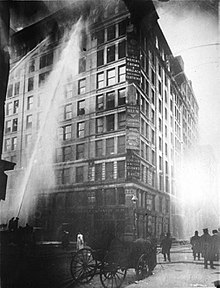
- 25 March 1911 (United States)
- Triangle Shirtwaist Factory fire -- The Triangle Shirtwaist Company, occupying the top three floors of a ten-story building in New York City, was consumed by fire. One hundred and forty-six people, mostly women and young girls working in sweatshop conditions, died.[26]
- 1912 (United States)
- Massachusetts passes the first minimum wage law for women and minors.[26]
- 1912 (United States)
- Chicago newspaper strike occurred.[26]
- 1912 (United States)
- Fur Workers' Strike occurred.[26]
- 1912 (United States)
- IWW Free Speech Fight occurred in San Diego, California.[26]
- 1912 (United States)
- New York City Hotel Strike occurred.[26]


- January–March 1912 (United States)
- Lawrence Textile Strike in Lawrence, Massachusetts, often known as the "Bread and Roses" Strike. Dozens of different immigrant communities united under the leadership of the Industrial Workers of the World (IWW) in a largely successful strike led to a large extent by women. The strike is credited with inventing the moving picket line, a tactic devised to keep strikers from being arrested for loitering.[26]
- It also adopted a tactic used before in Europe, but never in the United States, of sending children to sympathizers in other cities when they could not be cared for by strike funds. On 24 February, women attempting to put their children on a train out of town were beaten by police, shocking the nation.[23][28]
- 18 April 1912 (United States)
- The National Guard was called out against striking West Virginia coal miners at the Paint Creek and Cabin Creek, West Virginia mines.[26]
- 7 July 1912 (United States)
- Striking members of the Brotherhood of Timber Workers and supporters are involved in an armed confrontation with the Galloway Lumber Company and supporters in the Grabow Riot, resulting in four deaths and 40 to 50 wounded.[26]
- 1913 (United States)
- U.S. Department of Labor established.[26]
- 1913 (United States)
- Machinists Strike and Boycott[26]
- 1913 (United States)
- Michigan Copper Strike[26]
- 1913 (United States)
- Paterson, New Jersey, Textile Strike[26]
- 1913 (United States)
- Rubber Workers' Strike[26]
- 1913 (United States)
- Studebaker Motors Auto Workers' Strike[26]
- 1913 (United States)
- Wheatland, California, Hop Riot[26]
- 11 June 1913 (United States)
- Police shot into a crowd of maritime workers (two of whom was killed) who were striking against the United Fruit Company in New Orleans.[29]: 58–59

- 1914 (United States)
- According to a report by the Commission on Industrial Relations, approximately 35,000 workers were killed in industrial accidents and 700,000 workers were injured in the U.S.
- 1914 (United States)
- U.S. Congress passes the Clayton Antitrust Act limiting the use of injunctions in labor disputes.[26]
- 1914 (United States)
- Amalgamated Clothing Workers founded.[26]
- 1914 (United States)
- Fulton Bag and Cotton Mill Strike occurred.[26]
- 5 January 1914 (United States)
- The Ford Motor Company raised its basic wage from $2.40 for a nine-hour day to $5 for an eight-hour day.

- 14 January 1914 (United States)
- Labor leader Joe Hill was arrested in Salt Lake City, Utah. He was convicted on murder charges, and was executed 21 months later despite worldwide protests and two attempts to intervene by President Woodrow Wilson. In a letter to Bill Haywood shortly before his death he penned the famous words, "Don't mourn - organize!"


- 20 April 1914 (United States)
- The "Ludlow Massacre." In an attempt to persuade strikers at Colorado's Ludlow Mine Field to return to work, company "guards," engaged by John D. Rockefeller Jr. and other mine operators and sworn into the State Militia just for the occasion, attacked a union tent camp with machine guns, then set it afire. Five men, two women and 12 children died as a result.
- 20 May 1914 (United States)
- 1914–1915 Fulton Bag and Cotton Mills strike begins in Atlanta, Georgia.
- 13 November 1914 (United States)
- A Western Federation of Miners strike is crushed by the militia in Butte, Montana.
- 1915 (United States)
- U.S. Congress passed the La Follette Seamen's Act regulating working conditions for seamen.[26]
- 1915 (United States)
- Bayonne refinery strikes of 1915–1916 against Standard Oil began.[26]
- 1915 (United States)
- Youngstown, Ohio, Steel Strike occurred.[26]
- 19 January 1915 (United States)
- Twenty rioting strikers were shot by factory guards at Roosevelt, New Jersey.
- 25 January 1915 (United States)
- The Supreme Court upholds "yellow dog" contracts, which forbid membership in labor unions.
- 1916 (United States)
- U.S. Congress passed the Federal Child Labor Law, which was later ruled unconstitutional.[26]
- 1916 (United States)
- U.S. Congress passed the Adamson Act, which established an eight-hour workday for railroad workers.[26]
- 1916 (United States)
- American Federation of Teachers founded.[26]
Text je dostupný za podmienok Creative Commons Attribution/Share-Alike License 3.0 Unported; prípadne za ďalších podmienok. Podrobnejšie informácie nájdete na stránke Podmienky použitia.
Antropológia
Aplikované vedy
Bibliometria
Dejiny vedy
Encyklopédie
Filozofia vedy
Forenzné vedy
Humanitné vedy
Knižničná veda
Kryogenika
Kryptológia
Kulturológia
Literárna veda
Medzidisciplinárne oblasti
Metódy kvantitatívnej analýzy
Metavedy
Metodika
Text je dostupný za podmienok Creative
Commons Attribution/Share-Alike License 3.0 Unported; prípadne za ďalších
podmienok.
Podrobnejšie informácie nájdete na stránke Podmienky
použitia.
www.astronomia.sk | www.biologia.sk | www.botanika.sk | www.dejiny.sk | www.economy.sk | www.elektrotechnika.sk | www.estetika.sk | www.farmakologia.sk | www.filozofia.sk | Fyzika | www.futurologia.sk | www.genetika.sk | www.chemia.sk | www.lingvistika.sk | www.politologia.sk | www.psychologia.sk | www.sexuologia.sk | www.sociologia.sk | www.veda.sk I www.zoologia.sk
